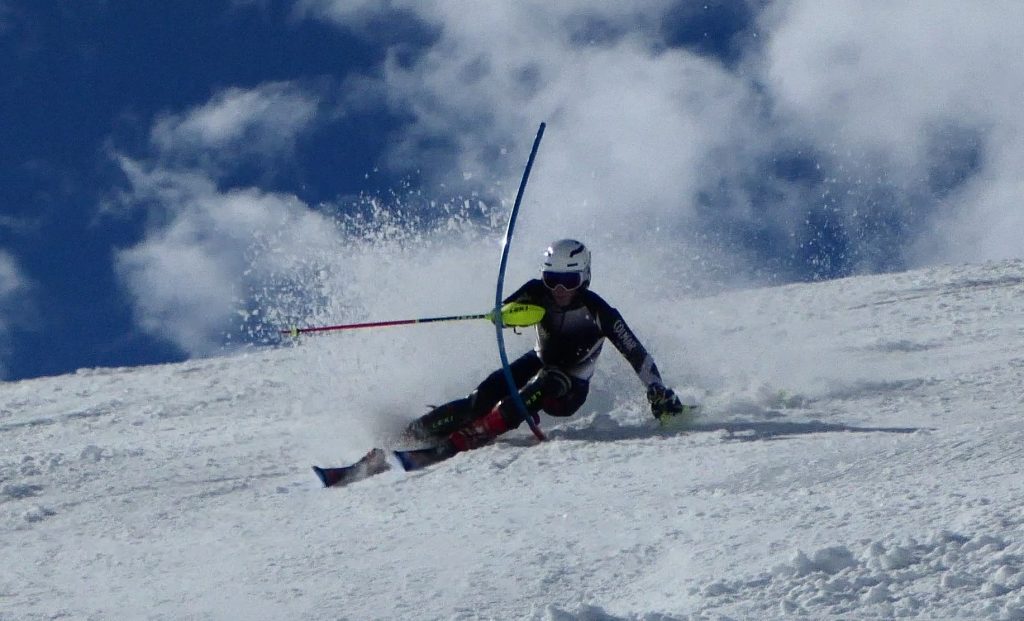Rocking the feet
Both feet need to be rocked onto their inside edges at all times. This rocking takes place in the “subtaler” joint between the heel and the ankle and can be felt with pressure against the inside of the ankle against the boot and with the forefoot turning outward inside the boot. I’ve actually worn holes clean through my inner boots at the inside of my ankles in the past.
When the outside ski is pressured this foot effectively counter-rotates inside the ski boot – the opposite to twisting it in the turn direction.
Coordinate the foot action with pulling inward (toward the turn centre) with the adductor muscles (inside of upper leg) and projecting the Centre of Mass inward – maintaining this even during the turn completion when the Centre of Mass comes out of the turn as you allow the ski to cut underneath your trajectory and lift you up.
Angulation
There’s some information here explaining the safe and effective way to produce hip angulation…
http://madeinmountains.com/chiskiing/
Each skier was able to feel the postural reflex – this is seriously important – protect the lower back always when skiing. Never force the shoulders and chest to “face downhill” – only do that with the pelvis! This provides great hip angulation!

Dynamics for exiting a turn
Dynamics getting out of a turn is even more important than dynamics getting into a turn. In the photo above Alex would actually retract both his legs at the end of the turn as there will be excessive force already. In slower skiing you need to complete the turn more – almost turning back up the hill – to generate enough force to lift you up and out of the existing turn and over the top of the downhill ski.
Pole Carriage
When using free dynamics in skiing and with the skis travelling forward across the hill you do not ever want to stick the ski pole in the ground. The downhill pole is simply held in place already and only a flick forward at the wrist is required – the body inclining into the new turn automatically making the pole touch the snow simply for feedback.
Video Feedback
Harry – Mr Zero Angulation. This must be Harry’s superpower. He clearly doesn’t want to diminish his 6ft 4ins stature by bending anywhere. Watch the body rotating with the inside hand disappearing behind Harry’s back. Absence of angulation manifests itself mainly as body rotation. The effect is to put weight on two skis at once instead of having all the weight securely on the outside ski. Not enough pressure on the fronts of the skis. Despite this Harry was clearly managing to use dynamics to get out of most of the turns – and that was the intended focus.
(For Harry… yes we are in an Ice Age – this is currently an interglacial warm period! https://en.wikipedia.org/wiki/Quaternary_glaciation )
Georgia – your skiing is coming alive. Dynamics both into and out of the turns were obvious regardless of the terrain. Just a bit too much rotation going on and more angulation needed. We don’t reach for a pole touch with the arms! The arms need to be carried correctly in front and out to the side then only the wrist moves the pole and the motion of the centre of mass causes the touch against the snow. Better independence of the legs than Harry due to being better centered fore/aft with the whole ski working. We established that the hips are stiff for some reason (probably tension) which works against facilitating angulation.
Cori – Dynamics were clear going into the turn but the stance was too wide to enable the centre of mass to come out over the lower ski in the turn completion. This caused the weight to get back a bit too much at times and for rotation to dominate. Good independent leg work though with pressure on the outside ski and stability.
Adrian – I have to assume Adrian is paying the bills because he is clearly the one trying the most diligently to change his skiing and get something out of this! Well done Adrian – there’s a bit of everything we’ve been working on happening there and it’s starting to look tidy and functional.
Ella – a strong skier – but not focused on this run and not using dynamics out of the turns. Tail flick to the side rushing the start of each turn – but Ella was fully aware she had this issue and just wasn’t focused. Only when you stand strongly on the one leg from start to end of the turn can you then sense what needs to be done to organise the movement pattern effectively.
Today’s views – Les Arcs 2000/1950






